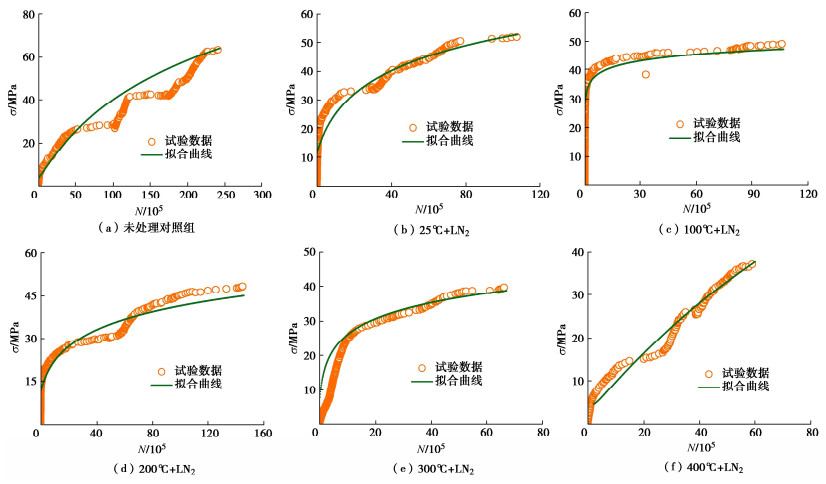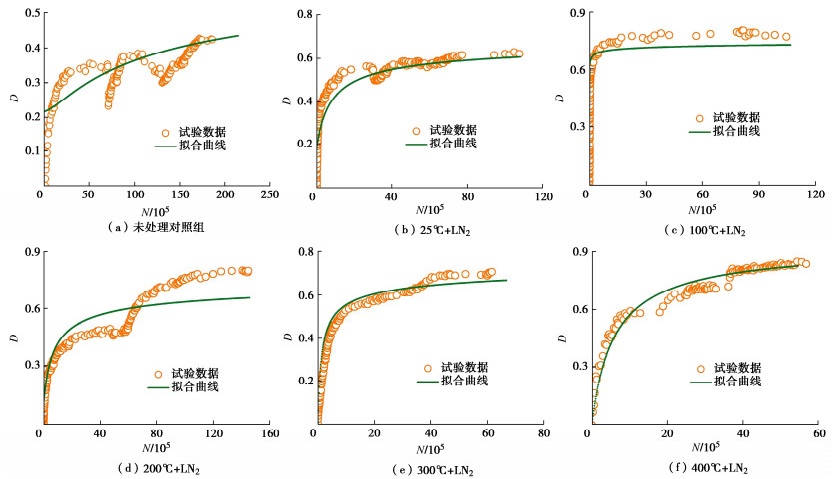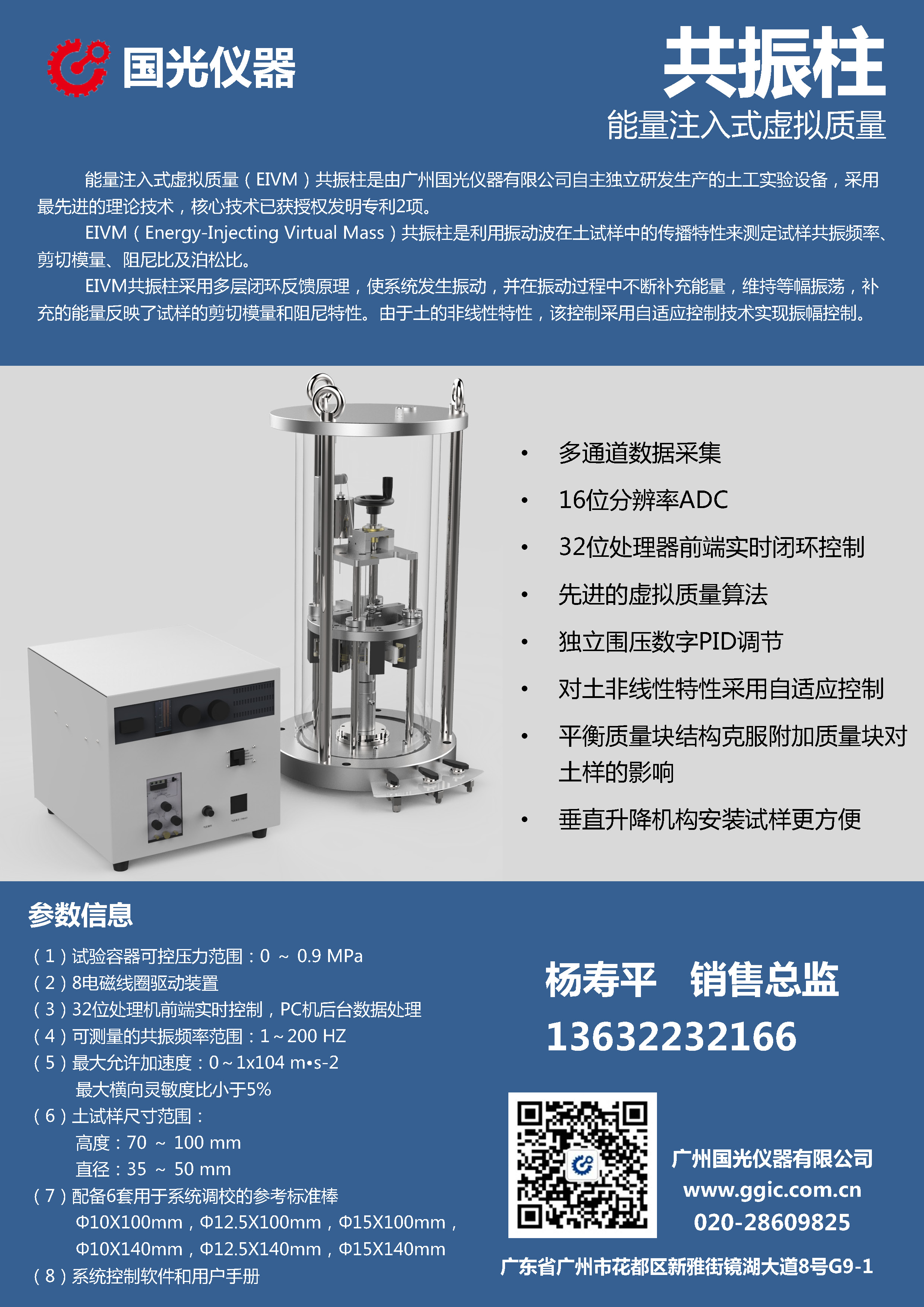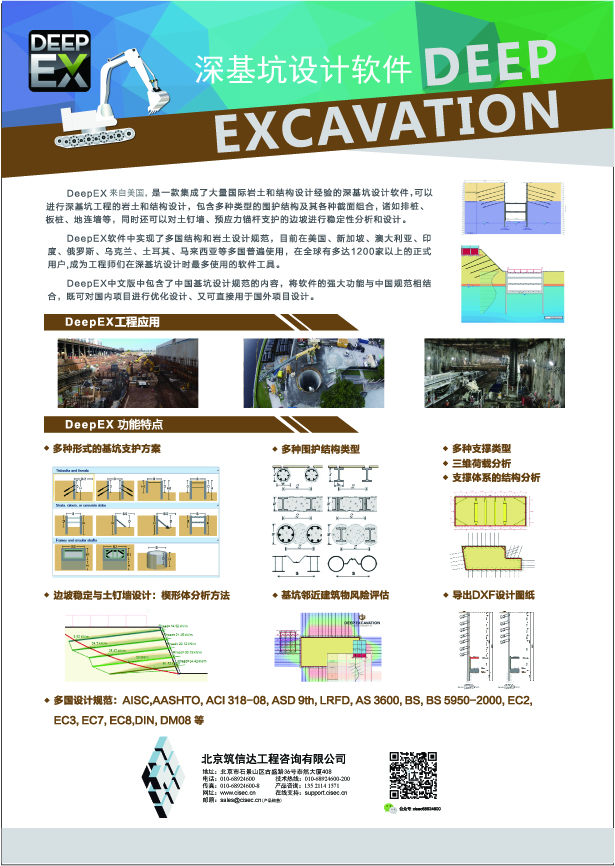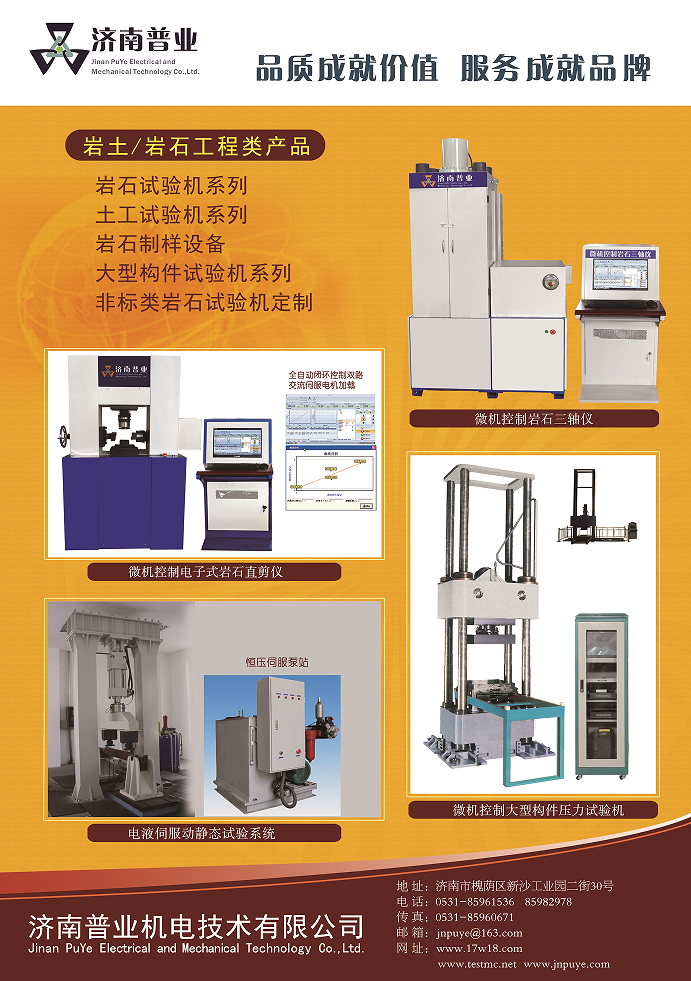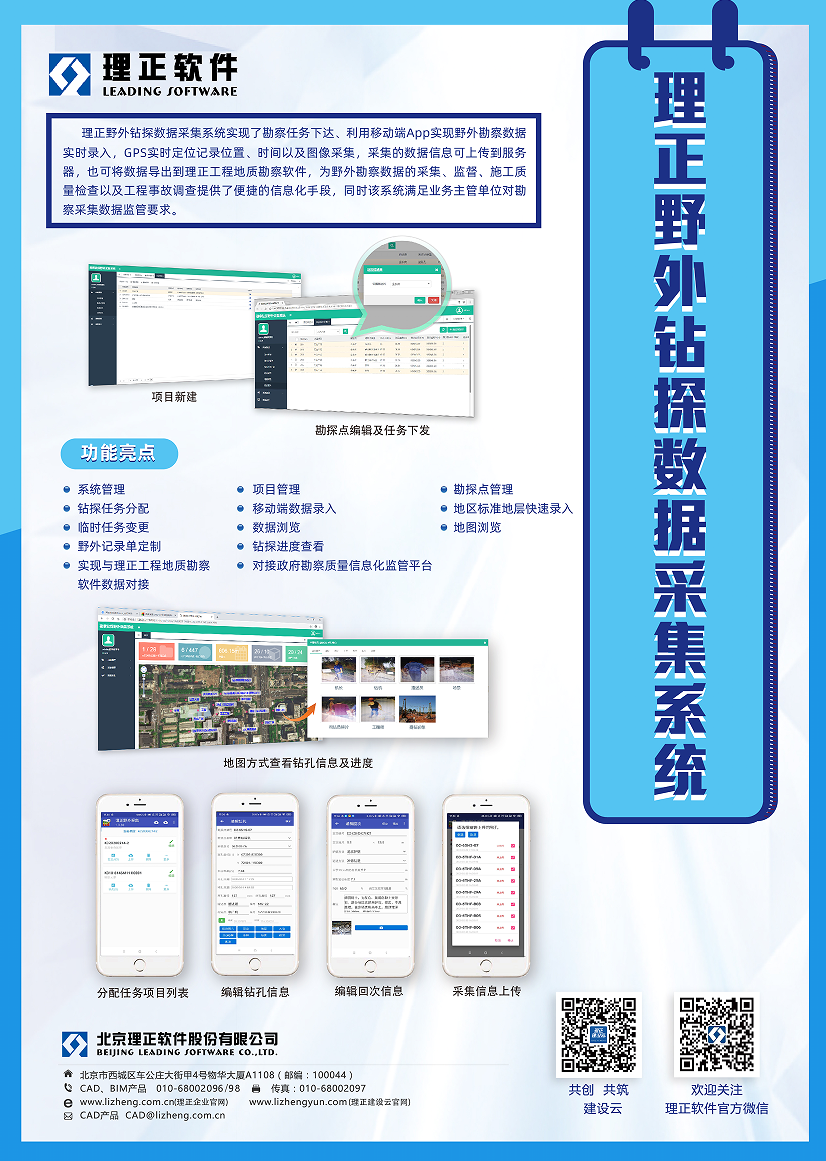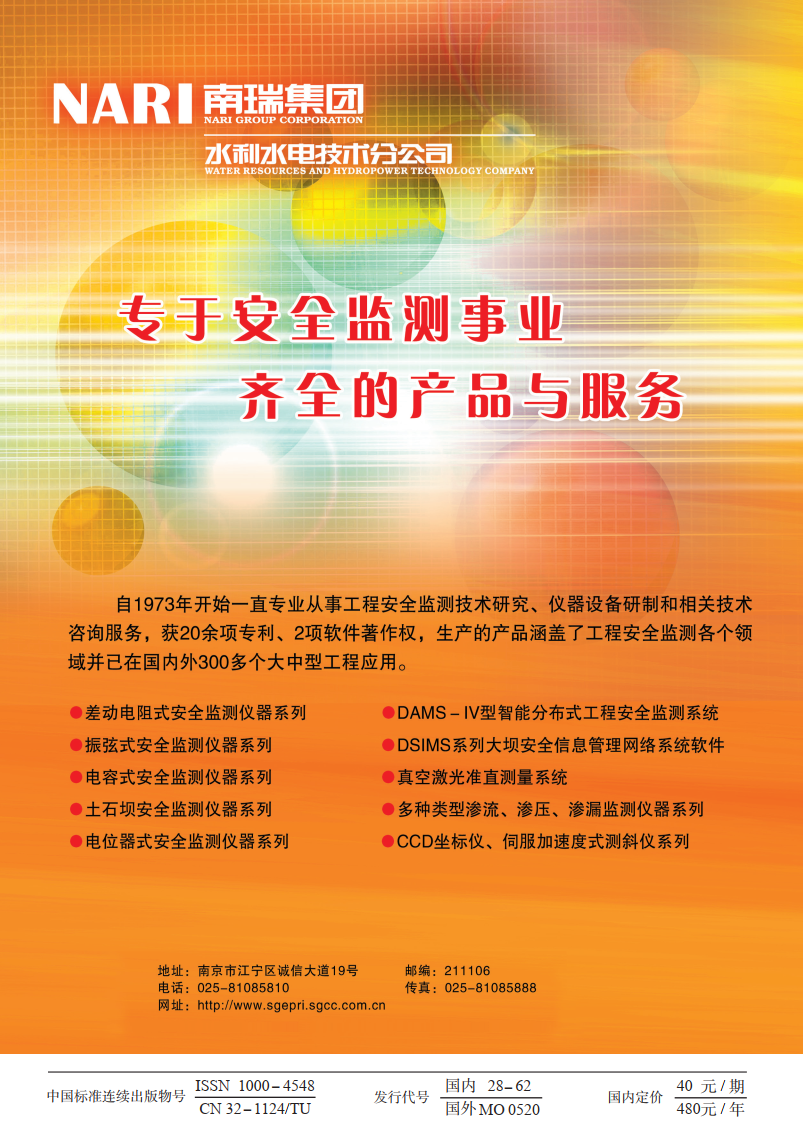Acoustic emission evolution characteristics and constitutive model for damage of granite after high-temperature heating and liquid nitrogen cold shock treatment
-
摘要: 通过液氮(LN2)压裂在储层中形成大规模裂隙网络,可以有效提高干热岩储层的热能提取效率。为研究液氮冷冲击作用对不同温度储层的压裂机理和致裂效果的影响,对经过高温加热(25℃~400℃)和液氮冷冲击处理后的花岗岩试样进行单轴压缩试验,分析了花岗岩力学强度及声发射等多项参数的演化特征,并进一步构建了考虑声发射参数的损伤本构模型,用于评价和预测高温加热-液氮冷冲击处理后花岗岩的变形和强度特征。结果表明:高温和液氮冷冲击的联合作用显著劣化了花岗岩力学性能,峰值强度逐渐降低,最大降幅达到32.8%。同时随着加热温度的升高,不同矿物颗粒之间的热膨胀变形存在差异,导致矿物颗粒之间变形不协调。随着初始加热温度的升高,声发射最大b值平均值显著上升,最大增幅达到32.2%,且声发射振铃计数的初始静默阶段对应的应变量大幅度降低,最大降幅达到54.3%。随着加热温度的升高,液氮冷冲击作用使得微裂纹的生长更为密集,花岗岩在外部荷载作用下,微裂隙不断扩展贯通,更容易形成剪切变形,发生剪切破坏的起始应力水平逐渐下降,最大降幅达到62.3%,同时RA-AF散点值在剪切区域占比增加,最大增幅达到29.5%。此外,本文以声发射振铃累计计数为变量构建了考虑声发射参数的损伤本构模型,能够描述不同高温和液氮冷冲击处理后花岗岩各力学参量在变形破坏过程中的演化特征。
-
关键词:
- 花岗岩 /
- 声发射 /
- 高温加热-液氮冷冲击 /
- 损伤破坏 /
- 本构模型
Abstract: By using the liquid nitrogen (LN2) fracturing to create a massive network of fractures in the reservoir, the thermal energy extraction efficiency of hot dry rock reservoirs can be effectively improved. To investigate the effects of LN2 cold shock treatment on the fracturing mechanism and fracture effects of reservoirs at different temperatures, the uniaxial compression tests are conducted on the granite samples undergone high-temperature heating (25℃~400℃) and liquid nitrogen cold shock treatment. The evolution characteristics of the mechanical strength and acoustic emission parameters of granite are analyzed, and an acoustic emission constitutive model for damage of granite is further established to evaluate and predict the deformation and strength characteristics of granite after high-temperature heating and liquid nitrogen cold shock treatment. The results indicate that the combined effects of high-temperature heating and LN2 cold shock significantly degrade the mechanical properties of granite, with the gradual decrease in the peak strength and the maximum reduction of 32.8%. Meanwhile, with the increase in the heating temperature, there are differences in the thermal expansion deformation between different mineral particles, resulting in a lack of coordination in deformation between mineral particles. With the increase in the initial heating temperature, the average maximum b-value of acoustic emission significantly increases, with the maximum increase of 32.2%, and the strain corresponding to the initial silent stage of acoustic emission ringing counts decreases significantly, with the maximum reduction of 54.3%. With the increase in the heating temperature, the LN2 cold shock treatment causes the microcracks to grow more densely. Under the external loading, the microcracks continuously expand and penetrate, making it easier for the granite to undergo shear deformation and for the initial stress level of shear failure to gradually decrease, with the maximum reduction of 62.3%. Meanwhile, the proportion of RA-AF scatter plot values in the shear zone increases, with the maximum increase of 29.5%. Additionally, an acoustic emission constitutive model is established using the accumulated ringing counts as a variable, which can describe the evolution characteristics of different mechanical parameters of granite during the deformation and failure process after high-temperature heating and LN2 cold shock treatment. -
0. 引言
地热能是极具利用价值的清洁能源,在缓解能源危机,改善生态环境方面发挥着重要作用[1]。其中干热岩(HDR)型地热能因其储量丰富、稳定、可靠和耐用等特点引发了广泛关注。干热岩是一种高温岩体,主要岩性为花岗岩,岩体致密,基本不含流体。由于其低孔隙度和低渗透性等特点,干热岩储层中的地热能资源很难被有效开发[2]。因此,为了提高热提取效率,通常采用增强型地热系统(EGS),通过水力压裂的方式增加储层的渗透性和裂隙连通性[3-4]。
与常规水力压裂相比,液氮压裂在储层内部建立高渗透性裂隙通道方面具有独特的优势。液氮在常压下能保持液态流动且制备容易,同时作为一种无水增产技术,可以有效降低环境污染,避免水资源浪费[5-6]。干热岩储层的温度范围在150℃~500℃[7-8],液氮作为一种低温流体(-195.8℃),液氮压裂的温差可达350℃~700℃,冷冲击作用可以诱发地层内部的热裂纹产生,形成大规模的裂隙网络,从而大幅度提升储层压裂效率[9-10]。
由于液氮的超低温属性,LN2冷冲击作用诱导的强烈热应力会对岩石的微观结构造成一定程度的破坏,从而对岩石的物理力学性质产生影响,造成抗压强度、抗拉强度、弹性模量等力学性能下降[11-12]。低温液氮可以通过制造次生裂纹、延长既有裂纹、促进裂隙滑移等方式显著提升岩体的渗透性[13-14]。Zhang等[15]提出通过液氮射流刺激干热岩储层,发现经过液氮射流处理后,高温花岗岩热裂纹大量增加,且裂纹数目和大小随着注入流体与岩石之间的温差增大而增加。液氮对高温花岗岩的致裂作用主要是由于快速冷却形成的热应力施加于岩体内部,破坏矿物颗粒之间的胶结作用,致使微裂缝萌生、扩展、交叉,最终形成大规模的裂隙网络[16-17]。
声发射(AE)技术可以监测温度改变诱发热应力造成的岩石内部缺陷和损伤演化过程[18-19]。Sha等[20]在热处理后的岩样单轴压缩试验中发现,热处理温度低于300℃,应力会出现略微下降的现象,且下降点处的应变值对应的声发射计数急剧上升。由于孔隙水蒸发,矿物颗粒错位或晶界运动导致瞬态应力松弛,声发射信号活动剧烈。研究液氮冷冲击处理后岩石的应力-应变关系及本构特征,对于干热岩储层的可压裂性评价和压裂效果预测有着重要意义[21-22]。刘泉声等[23]考虑到了弹性模量的演化过程,进而定义了热损伤变量并推导出花岗岩的损伤本构方程,同时分析了损伤能量释放率随温度的变化。蒋浩鹏等[24]在现有岩石统计损伤本构模型基础上,考虑微元体强度服从莫尔-库仑准则,引入Weibull分布函数和热损伤变量,建立了适用于高温环境的岩石统计损伤本构模型。
本文对不同温度加热-液氮冷冲击处理后的花岗岩进行单轴压缩试验研究,探讨了不同加热温度及液氮冷冲击对花岗岩损伤破坏的影响。建立了高温加热-液氮冷冲击处理后花岗岩考虑声发射参数的损伤本构模型,并基于试验数据对本构模型的适用性进行验证。研究结果对液氮压裂技术在地热储层改造中的应用提供了一定的试验参考依据。
1. 试验材料及方法
1.1 试样制备
试验所采用的花岗岩取自江苏省徐州市,岩样表面呈银白色并含黑斑,造岩矿物颗粒较粗,纹理均匀,无可见缺陷。从矿区采出后,根据ISRM推荐的规范对原岩进行钻取、切割、打磨等,最终制成高100 mm,直径50 mm的标准圆柱试样。为保证两端面的光滑平整,对样品的端部进行了研磨抛光,平整度控制在0.02 mm。试样均是从同一块岩块中钻取,具有良好的完整性和均质性。
1.2 试验设备
单轴压缩试验所用仪器为TAWD-2000电液伺服岩石力学性能测试系统(图 1)。通过该系统可以对岩石进行多种力学试验。声发射采用的是PCI-2型声发射系统,该系统是由美国物理声学公司(PAC)生产,具有较为精准的信号探测能力,可用以实时监测岩石内部损伤情况及裂纹发育动态。采用XMA-2000电热恒温干燥箱用于试样加热,其输出功率为2000 W,控温范围为RT+10℃-300℃,控温精度为±1%,恒温波动度为±1℃。
1.3 试验流程
试验流程包括3个部分:试样挑选;高温加热-液氮冷却处理;单轴压缩试验及声发射测试。
(1)标准圆柱试样制备后,利用NM-4A非金属超声检测分析仪测量试样的纵波波速,挑选将波速相近的试样分为一组,可减少试样自身结构差异造成的试验误差。
(2)试样处理阶段,将花岗岩试样分为6组,前5组中,一组试样放置于室温状态下(室温25℃)不进行加热处理,剩余4组试样分别加热至100℃,200℃,300℃和400℃,而后将5组试样均放入液氮中进行冷却处理。最后一组作为常温对照组,不做加热和冷却处理。花岗岩试样加热过程在XMA-2000电热恒温干燥箱中进行。为避免加热引起的热冲击效应,试验采用5℃/min的低加热速率,将岩样加热至预设温度。达到目标温度后,恒温3 h,确保充分加热。随后将岩样从干燥箱内取出并立即浸入液氮罐中,在液氮中冷却持续1 h。待完全冷却后取出静置至常温。在进行下一步测试前,所有样品在室温下自然风干24 h。
(3)花岗岩试样处理完成后,利用TAWD-2000电液伺服岩石力学性能测试系统和PCI-2型声发射系统进行单轴压缩及声发射试验。加载前将声发射探头安装于试样侧面,进行六探头的分布安装,试样上下两侧各3个探头均匀插空分布,任意两探头之间以120°夹角定位,上下侧的探头距离试样上下端面分别为10 mm。前置放大器增益设置为40 dB,门槛值为35 dB,采样速率为4MSPS,撞击时间为50 μs,撞击间隔为300 μs。单轴压缩试验以50 N/s的速率施加轴向压力,峰后阶段采用轴向变形控制方式进行加载,加载速率设定为0.003 mm/s。加载过程中,计算机实时记录位移载荷数据以及声发射数据。
2. 高温加热-液氮冷冲击处理后的花岗岩声发射参数分析
2.1 花岗岩声发射振铃计数特征
图 2给出了高温加热-液氮冷冲击处理后花岗岩在单轴试验压缩过程中的应力、声发射振铃计数、声发射振铃计数演化特征。在弹性变形阶段,轴向应力-应变曲线以直线形式分布,声发射事件仍然较少。在裂纹稳定扩展阶段,已经闭合的裂隙和微裂纹在轴压的作用下开始扩展,声发射事件数开始增加,应力应变曲线呈现出一定的非线性特征,但各项声发射参数处于逐渐增长的状态在裂纹非稳定扩展阶段,花岗岩内部的裂缝扩展加剧,甚至形成贯通裂纹,声发射信号突增,承载能力降低。最终达到破坏阶段,花岗岩内部裂隙扩大到无法承受轴向压力而崩落断裂,应力急剧降低。通过图 2可知,随着加热温度由25℃增加到400℃,花岗岩试样峰值强度逐渐降低,下降幅度达到32.8%。随着加热温度的升高,热破裂使花岗岩内部结构发生劣化,降低其力学强度。加热温度由100℃增加到200℃时,峰值强度略有增加,可能是由于热膨胀变形和部分晶体熔化使花岗岩内部结构变得紧密,导致原始微裂纹闭合,提高了花岗岩的承载能力。此外,从图 2中发现随着加热温度由25℃增加到400℃,声发射振铃计数的静默阶段所对应的应变值逐渐变短,缩短约54.3%。证明在岩样初始加载阶段就更容易检测到显著的声发射信号,也进一步说明温度梯度越大,液氮冷冲击可以有效加速微裂纹在储层中的扩展、交汇、贯通。
2.2 声发射b值分析
b值分析是一种常见的岩石声发射特性分析手段, 其概念最早由Gutenberg等[25]于1941年提出,最先用于地震学研究,来描述地震频度随震级按指数减少的规律,提出的G-R关系式如下所示:
lgN=a−bM。 (1) 式中:N为地震次数;M为地震震级;a,b为常数。在计算声发射b值时,通常以声发射的振幅值除以20来代替地震的震级M[26]。对于N,通过选取振幅大于A的特定时间窗口中的声发射命中次数来进行表示,其中A为声发射振幅值。
为确定b值,可在每个采样窗口中选取相等数量的声发射事件。b值的误差随着样本数量的增加而降低[27]。Pickering等[28]认为选取样本大于200个事件,b值就接近于最小误差。为了保证b值的可靠性,本文选取500个声发射事件作为滑动时间窗口来计算b值。通过对高温加热-液氮冷冲击处理后的花岗岩声发射b值进行统计,得出了图 3中不同工况下的变化情况。
图 3为高温加热-液氮冷冲击处理后的花岗岩b值变化情况。随着应力水平的增加,各温度下花岗岩的声发射b值变化均呈现出上升-平缓-下降的一个分布趋势。当应力水平增加到20%左右时,b值总体处于上升状态,此时花岗岩中的微裂隙和微裂纹开始逐渐增多,对应于初始压密阶段。当应力水平达到20%~80%,b值呈现振荡分布的特征,但总体趋于缓慢增加状态,维持在1.3~1.4。加热温度越高,花岗岩声发射b值的振荡幅度越剧烈,即高温和冷冲击使得花岗岩内部破裂加剧,裂隙发育更密集,大量微裂缝形成且有大裂缝及贯通裂纹生成,对应于弹性变形、裂缝稳定发展以及裂缝非稳定发展阶段。由于液氮冷冲击造成岩体内部结构微劣化,其损伤情况相较于未经过处理的岩样要更加严重,未处理岩样的b值水平略低于高温-液氮冷冲击处理后的试样。当应力水平超过80%,宏观裂隙的占比迅速增加,b值下降。
为了更加直观展现b值随加热温度的演化特征,分析了最大b值及整体b值与加热温度之间的对应关系。其中,最大b值根据不同应力阶段b值的最大值确定,整体b值通过试样的整体数据计算确定。为保证其准确性,采用多个试样b值的平均值来确定。最大b值在25℃~300℃处于增大状态,上升12.7%,300℃~400℃上升趋势更大,上涨19.5%。整体b值与最大b值的变化趋势情况相似,在25℃~300℃上升6.9%,300℃~400℃,上涨10.1%。
2.3 声发射RA、AF值分析
声发射RA-AF值可用来表征花岗岩破坏过程中裂纹扩展的方式。RA是上升时间与最大幅值之间的比值。当RA值越大,则声发射波形达到相同幅值所需要的上升时间就会更长,当RA值越小,在同等的上升时间过程中,声发射波形幅值增长速度就会更快。AF值是振铃计数和持续时间的比值。当AF值越大,则在同一持续时间的声发射振铃计数越多,当AF值越小,则达到相同振铃计数所用的持续时间越长。利用其可以区分拉伸裂纹和剪切裂纹。
图 4为高温加热-液氮冷冲击处理后的花岗岩在加载条件下的RA和AF值演化特征。当RA超过AF,表明岩石内部的破裂以剪切裂隙为主。当RA小于AF,表明岩石内部的破裂以张拉裂隙为主。RA曲线与AF曲线的首次交汇点意味着岩石内部破裂模式的变化。随着加热温度的升高,RA曲线与AF曲线的首次交汇点对应的应力水平越来越低。从25℃工况下的61%逐渐降低至400℃工况下的23%,表面随着加热温度的升高,在低应力水平条件下就会出现了较多剪切微裂纹,导致试样更容易发生局部剪切破坏,从而诱发试样的宏观整体破坏。同时可以看到在大部分工况下,RA曲线与AF曲线的首次交汇后又出现了多次交汇,最终在应力峰值处呈现高RA低AF状态,预示了内部破裂模式的复杂演化特征以及最终的剪切破坏模式。
图 5给出了高温加热-液氮冷冲击处理后的花岗岩加载期间RA和AF值的散点分布情况。对RA和AF值进行了归一化处理,根据RA-AF的数值确定最佳过渡线,并划分出拉伸破坏区域和剪切破坏区域,对花岗岩试样的主要破坏形式进行比对分析。不同工况下的试样散点分布趋势有着明显变化。随着加热温度的升高,大部分散点分布逐渐从拉伸破坏区域转变到剪切破坏区域。其剪切破坏区域散点分布数量由25℃工况下的57.7%上升为400℃工况下的91.2%。即加热温度越高,花岗岩内部的损伤破坏越严重,产生的微裂纹更多,而微裂纹的增多更容易造成宏观破坏的发生。
3. 加热-液氮处理后考虑声发射参数的损伤本构模型
花岗岩的强度和变形等力学性质会受到内部裂隙、节理等因素的影响。声发射系统可以对加载过程中花岗岩试样的内部损伤破坏进行实时记录。本试验在加载过程中对声发射振铃计数、应变、应力等数据进行同步监测,根据应变ε与时间t的拟合情况得出两者为线性关系,表示为
ε=kt+ε0。 (2) 式中:k为花岗岩应变率;ε0为花岗岩初始应变,两个参数均可通过线性拟合得到。
对花岗岩声发射振铃累计计数N与时间t曲线进行数据拟合,损伤情况下花岗岩的声发射振铃累计计数与时间的函数关系可以采用指数函数进行表征,此时N与t的函数关系可表示为
N=A1exp(B1t)+C。 (3) 式中:A1,B1,C均为参数,由试验数据拟合得到。
由式(2),(3)联立,得到声发射振铃累计计数与应变的耦合关系,表示为
N=A1exp(B1(ε−ε0)k)+C。 (4) 根据Lemaitre应变等价性假说,可以将单轴压缩条件下的损伤本构模型表示为
σ=Eε(1−D)。 (5) 式中:σ为有效应力;E为材料初始弹性模量;ε为应变;D为损伤因子。
假设连续性材料的微元强度满足Weibull分布,即
Φ(ε)=mα(εα)m−1exp[−(εα)m]。 (6) 式中:m为Weibull分布的形状参数,α为Weibull分布的尺寸参数。
损伤变量D与微元破坏的概率密度关系:
dDdε=Φ(ε)。 (7) 由式(6)和式(7)得
D=∫ε0Φ(ε)dε=1−exp(−εmα)。 (8) 将式(8)代入式(5),得花岗岩应力-应变本构模型:
σ=Eεexp(−εmα)。 (9) 其中,参数m,α通过试验数据拟合得到。
联立式(4),(9),得到声发射累计计数N与应变ε,应力σ,损伤因子D之间的耦合关系:
σ=Eεexp[−1α(kB1lnN−CA1+ε0)m], (10) ε=kB1lnN−CA1+ε0, (11) D=1−exp[−1α(kB1lnN−CA1+ε0)m]。 (12) 为了检验模型的正确性及合理性,采用试验数据进行验证。将试验数据带入模型,得到相关参数,如表 1所示。并进一步确定花岗岩声发射振铃累计计数与应力、损伤之间的关系,如图 6,7所示。
表 1 Weibull分布与拟合参数表Table 1. Parameters for Weibull distribution and fitting试样编号 处理措施 Weibull分布 拟合参数 m α A1 B1 C k ε0 Untreated -1 不处理 -1.78 1.22 0.7261 0.3036 -26.6 0.07659 -0.3779 Untreated-2 -1.59 1.43 0.9654 0.5638 -17.9 0.08867 -0.4738 25-1 25℃+LN2 -1.445 6.357 1.48054 0.01243 -5.88255 0.00166 0.14985 25-2 -1.636 47.82 11.41 1.194 -7.369E-06 0.04658 0.4986 100-1 100℃+LN2 -0.431 68.16 4.762E-05 2.872 -4.167E-08 0.1558 -0.01105 100-2 -0.699 59.73 4.085E-06 0.9768 -9.886E-05 0.02678 -0.0271 200-1 200℃+LN2 -1.511 26.63 0.59994 0.01529 -5.02845 0.00166 -0.01004 200-2 -1.194 47.75 0.2855 0.08134 -2.692E-08 0.003706 0.4613 300-1 300℃+LN2 -0.7796 -11.18 66.98773 0.00184 -74.97969 0.0016 -0.08416 300-2 32.54 13.49 0.6103 0.7746 -0.483 0.09329 0.2313 400-1 400℃+LN2 -1.162 37.31 1.051 0.8312 -0.4491 0.1164 0.167 400-2 -1.503 25.91 21.03 0.2642 -0.489 0.02983 0.6208 应力-声发射振铃累计计数试验结果与本构模型计算结果在峰前阶段有较好的一致性。同时,损伤变量曲线符合实测数据的变化情况。在达到屈服极限前,花岗岩破坏过程中包括压密和弹性变形两个阶段。这两个阶段的压缩变形状态比较稳定,具有一定的可预测性,因此在峰前阶段的曲线吻合度较高。峰后阶段,花岗岩出现了明显的宏观破裂,导致了声发射变化的随机性也增大,此时本构模型计算结果与实测数据有一定的差异。
试验数据与模型数据的比对表明,应力-声发射振铃累计数关系曲线在应力峰值之前具有较好的一致性。总体而言,花岗岩应力-声发射振铃累计计数与模拟的吻合度及相关性较好,证明了所建模型的合理性与有效性。
4. 结论
(1)当加热温度在25℃~400℃时,经过高温-液氮处理后的花岗岩力学强度逐渐弱化,峰值应力下降32.8%,主要是由于热应力与冷冲击对花岗岩的劣化产生较大的影响,影响作用会随着温度的增加变得更加显著。
(2)对于花岗岩内部损伤情况,可以用声发射参数进行描述。当高温-液氮冷冲击的加热温度在25℃~400℃时,花岗岩声发射最大b值平均值上升32.2%,声发射振铃计数的静默阶段所对应的应变值缩短54.3%。同时发生剪切破坏的起始应力水平下降了约62.3%。RA-AF的散点在剪切区域占比增加了33.5%。该现象主要是由于高温使得花岗岩内部产生热应力,加上液氮冷冲击破坏其内部结构产生大量微裂缝造成。根据RA-AF散点图,剪切破坏区域中的散点数量随着加热温度的升高而增加,即发生剪切破坏的事件增多。
(3)根据试验所得花岗岩各项力学参数及声发射参量,得出声发射累计振铃计数、应变与时间的拟合关系,进而推导出花岗岩声发射振铃累计计数与应变之间的关系函数。同时结合连续损伤力学基本理论,提出了高温加热-液氮冷冲击条件下考虑声发射参数的花岗岩损伤本构模型。并利用试验数据验证了模型的可行性与准确性。
-
表 1 Weibull分布与拟合参数表
Table 1 Parameters for Weibull distribution and fitting
试样编号 处理措施 Weibull分布 拟合参数 m α A1 B1 C k ε0 Untreated -1 不处理 -1.78 1.22 0.7261 0.3036 -26.6 0.07659 -0.3779 Untreated-2 -1.59 1.43 0.9654 0.5638 -17.9 0.08867 -0.4738 25-1 25℃+LN2 -1.445 6.357 1.48054 0.01243 -5.88255 0.00166 0.14985 25-2 -1.636 47.82 11.41 1.194 -7.369E-06 0.04658 0.4986 100-1 100℃+LN2 -0.431 68.16 4.762E-05 2.872 -4.167E-08 0.1558 -0.01105 100-2 -0.699 59.73 4.085E-06 0.9768 -9.886E-05 0.02678 -0.0271 200-1 200℃+LN2 -1.511 26.63 0.59994 0.01529 -5.02845 0.00166 -0.01004 200-2 -1.194 47.75 0.2855 0.08134 -2.692E-08 0.003706 0.4613 300-1 300℃+LN2 -0.7796 -11.18 66.98773 0.00184 -74.97969 0.0016 -0.08416 300-2 32.54 13.49 0.6103 0.7746 -0.483 0.09329 0.2313 400-1 400℃+LN2 -1.162 37.31 1.051 0.8312 -0.4491 0.1164 0.167 400-2 -1.503 25.91 21.03 0.2642 -0.489 0.02983 0.6208 -
[1] 王贵玲, 刘彦广, 朱喜, 等. 中国地热资源现状及发展趋势[J]. 地学前缘, 2020, 27(1): 1-9. https://www.cnki.com.cn/Article/CJFDTOTAL-DXQY202001002.htm WANG Guiling, LIU Yanguang, ZHU Xi, et al. The status and development trend of geothermal resources in China[J]. Earth Science Frontiers, 2020, 27(1): 1-9. (in Chinese) https://www.cnki.com.cn/Article/CJFDTOTAL-DXQY202001002.htm
[2] 李德威, 王焰新. 干热岩地热能研究与开发的若干重大问题[J]. 地球科学: 中国地质大学学报, 2015(11): 1858-1869. https://www.cnki.com.cn/Article/CJFDTOTAL-DQKX201511008.htm LI Dewei, WANG Yanxin. Major issues of research and development of hot dry rock geothermal energy[J]. Earth Science: Journal of China University of Geosciences, 2015(11): 1858-1869. (in Chinese) https://www.cnki.com.cn/Article/CJFDTOTAL-DQKX201511008.htm
[3] 廖志杰, 万天丰, 张振国. 增强型地热系统: 潜力大、开发难[J]. 地学前缘, 2015, 22(1): 335-344. https://www.cnki.com.cn/Article/CJFDTOTAL-DXQY202001023.htm LIAO Zhijie, WAN Tianfeng, ZHANG Zhenguo. The enhanced geothermal system(EGS): huge capacity and difficult exploitation[J]. Earth Science Frontiers, 2015, 22(1): 335-344. (in Chinese) https://www.cnki.com.cn/Article/CJFDTOTAL-DXQY202001023.htm
[4] 许天福, 袁益龙, 姜振蛟, 等. 干热岩资源和增强型地热工程: 国际经验和我国展望[J]. 吉林大学学报(地球科学版), 2016, 46(4): 1139-1152. https://www.cnki.com.cn/Article/CJFDTOTAL-CCDZ201604012.htm XU Tianfu, YUAN Yilong, JIANG Zhenjiao, et al. Hot dry rock and enhanced geothermal engineering: international experience and China prospect[J]. Journal of Jilin University (Earth Science Edition), 2016, 46(4): 1139-1152. (in Chinese) https://www.cnki.com.cn/Article/CJFDTOTAL-CCDZ201604012.htm
[5] 曾义金. 干热岩热能开发技术进展与思考[J]. 石油钻探技术, 2015, 43(2): 1-7. https://www.cnki.com.cn/Article/CJFDTOTAL-SYZT201502001.htm ZENG Yijin. Technical progress and thinking for development of hot dry rock (HDR) geothermal resources[J]. Petroleum Drilling Techniques, 2015, 43(2): 1-7. (in Chinese) https://www.cnki.com.cn/Article/CJFDTOTAL-SYZT201502001.htm
[6] BOUDET H, CLARKE C, BUGDEN D, et al. "Fracking" controversy and communication: Using national survey data to understand public perceptions of hydraulic fracturing[J]. Energy Policy, 2014, 65: 57-67. doi: 10.1016/j.enpol.2013.10.017
[7] 尹欣欣, 蒋长胜, 翟鸿宇, 等. 全球干热岩资源开发诱发地震活动和灾害风险管控[J]. 地球物理学报, 2021, 64(11): 3817-3836. https://www.cnki.com.cn/Article/CJFDTOTAL-DQWX202111002.htm YIN Xinxin, JIANG Changsheng, ZHAI Hongyu, et al. Review of induced seismicity and disaster risk control in dry hot rock resource development worldwide[J]. Chinese Journal of Geophysics, 2021, 64(11): 3817-3836. (in Chinese) https://www.cnki.com.cn/Article/CJFDTOTAL-DQWX202111002.htm
[8] 董硕, 沙松, 蒙世仟, 等. 液氮冷却作用下三类高温岩石力学性能试验研究[J]. 东北大学学报(自然科学版), 2021, 42(11): 1591-1599. https://www.cnki.com.cn/Article/CJFDTOTAL-DBDX202111011.htm DONG Shuo, SHA Song, MENG Shiqian, et al. Experimental investigation of mechanical properties of three types of high temperature rocks after liquid nitrogen cooling[J]. Journal of Northeastern University (Natural Science), 2021, 42(11): 1591-1599. (in Chinese) https://www.cnki.com.cn/Article/CJFDTOTAL-DBDX202111011.htm
[9] SU S, HOU P, GAO F, et al. Changes in mechanical properties and fracture behaviors of heated marble subjected to liquid nitrogen cooling[J]. Engineering Fracture Mechanics, 2022, 261: 108256. doi: 10.1016/j.engfracmech.2022.108256
[10] 吴星辉, 李鹏, 郭奇峰, 等. 热损伤岩石物理力学特性演化机制研究进展[J]. 工程科学学报, 2022, 44(5): 827-839. https://www.cnki.com.cn/Article/CJFDTOTAL-BJKD202205001.htm WU Xinghui, LI Peng, GUO Qifeng, et al. Research progress on the evolution of physical and mechanical properties of thermally damaged rock[J]. Chinese Journal of Engineering, 2022, 44(5): 827-839. (in Chinese) https://www.cnki.com.cn/Article/CJFDTOTAL-BJKD202205001.htm
[11] ENAYATPOUR S, PATZEK T. Thermal shock in reservoir rock enhances the hydraulic fracturing of gas shales[C]// SPE/AAPG/SEG Unconventional Resources Technology Conference, OnePetro, 2013.
[12] FINNIE I, COOPER G A, BERLIE J. Fracture propagation in rock by transient cooling[C]// International Journal of Rock Mechanics and Mining Sciences & Geomechanics Abstracts, Pergamon, 1979, 16(1): 11-21.
[13] WU X G, HUANG Z W, SONG H Y, et al. Variations of physical and mechanical properties of heated granite after rapid cooling with liquid nitrogen[J]. Rock Mechanics and Rock Engineering, 2019, 52(7): 2123-2139. doi: 10.1007/s00603-018-1727-3
[14] 蔡承政, 李根生, 黄中伟, 等. 液氮压裂中液氮对岩石破坏的影响试验[J]. 中国石油大学学报(自然科学版), 2014, 38(4): 98-103. https://www.cnki.com.cn/Article/CJFDTOTAL-SYDX201404015.htm CAI Chengzheng, LI Gensheng, HUANG Zhongwei, et al. Experimental study on effect of liquid nitrogen on rock failure during cryogenic nitrogen fracturing[J]. Journal of China University of Petroleum (Edition of Natural Science), 2014, 38(4): 98-103. (in Chinese) https://www.cnki.com.cn/Article/CJFDTOTAL-SYDX201404015.htm
[15] ZHANG S K, HUANG Z W, ZHANG H Y, et al. Experimental study of thermal-crack characteristics on hot dry rock impacted by liquid nitrogen jet[J]. Geothermics, 2018, 76: 253-260. doi: 10.1016/j.geothermics.2018.08.002
[16] 张伟, 曲占庆, 郭天魁, 等. 热应力影响下干热岩水压致裂数值模拟[J]. 岩土力学, 2019, 40(5): 2001-2008. https://www.cnki.com.cn/Article/CJFDTOTAL-YTLX201905045.htm ZHANG Wei, QU Zhanqing, GUO Tiankui, et al. Numerical simulation of hydraulic fracturing in hot dry rocks under the influence of thermal stress[J]. Rock and Soil Mechanics, 2019, 40(5): 2001-2008. (in Chinese) https://www.cnki.com.cn/Article/CJFDTOTAL-YTLX201905045.htm
[17] 黄中伟, 位江巍, 李根生, 等. 液氮冻结对岩石抗拉及抗压强度影响试验研究[J]. 岩土力学, 2016, 37(3): 694-700, 834. https://www.cnki.com.cn/Article/CJFDTOTAL-YTLX201603012.htm HUANG Zhongwei, WEI Jiangwei, LI Gensheng, et al. An experimental study of tensile and compressive strength of rocks under cryogenic nitrogen freezing[J]. Rock and Soil Mechanics, 2016, 37(3): 694-700, 834. (in Chinese) https://www.cnki.com.cn/Article/CJFDTOTAL-YTLX201603012.htm
[18] YUAN H, SUN Q, GENG J, et al. Acoustic emission characteristics of high-temperature granite through different cooling paths[J]. Geomechanics and Geophysics for Geo-Energy and Geo-Resources, 2022, 8(3): 97. doi: 10.1007/s40948-022-00407-0
[19] 郭奇峰, 钱志海, 潘继良, 等. 高温花岗岩热冲击后力学特性及损伤演化规律研究[J]. 工程科学学报, 2022, 44(10): 1746-1754. https://www.cnki.com.cn/Article/CJFDTOTAL-BJKD202210012.htm GUO Qifeng, QIAN Zhihai, PAN Jiliang, et al. Mechanical properties and damage evolution of granite under high temperature thermal shock[J]. Chinese Journal of Engineering, 2022, 44(10): 1746-1754. (in Chinese) https://www.cnki.com.cn/Article/CJFDTOTAL-BJKD202210012.htm
[20] SHA S, RONG G, CHEN Z H, et al. Experimental evaluation of physical and mechanical properties of geothermal reservoir rock after different cooling treatments[J]. Rock Mechanics and Rock Engineering, 2020, 53(11): 4967-4991. doi: 10.1007/s00603-020-02200-5
[21] GAUTAM P K, VERMA A K, SHARMA P, et al. Evolution of thermal damage threshold of jalore granite[J]. Rock Mechanics and Rock Engineering, 2018, 51(9): 2949-2956. doi: 10.1007/s00603-018-1493-2
[22] 陈世万, 杨春和, 刘鹏君, 等. 热损伤后北山花岗岩裂隙演化及渗透率试验研究[J]. 岩土工程学报, 2017, 39(8): 1493-1500. doi: 10.11779/CJGE201708017 CHEN Shiwan, YANG Chunhe, LIU Pengjun, et al. Evolution of cracks and permeability of granites suffering from different thermal damages[J]. Chinese Journal of Geotechnical Engineering, 2017, 39(8): 1493-1500. (in Chinese) doi: 10.11779/CJGE201708017
[23] 刘泉声, 许锡昌. 温度作用下脆性岩石的损伤分析[J]. 岩石力学与工程学报, 2000, 19(4): 408-411. https://www.cnki.com.cn/Article/CJFDTOTAL-YSLX200004002.htm LIU Quansheng, XU Xichang. Damage analysis of brittle rock at high temperature[J]. Chinese Journal of Rock Mechanics and Engineering, 2000, 19(4): 408-411. (in Chinese) https://www.cnki.com.cn/Article/CJFDTOTAL-YSLX200004002.htm
[24] 蒋浩鹏, 姜谙男, 杨秀荣. 基于Weibull分布的高温岩石统计损伤本构模型及其验证[J]. 岩土力学, 2021, 42(7): 1894-1902. https://www.cnki.com.cn/Article/CJFDTOTAL-YTLX202107014.htm JIANG Haopeng, JIANG Annan, YANG Xiurong. Statistical damage constitutive model of high temperature rock based on Weibull distribution and its verification[J]. Rock and Soil Mechanics, 2021, 42(7): 1894-1902. (in Chinese) https://www.cnki.com.cn/Article/CJFDTOTAL-YTLX202107014.htm
[25] GUTENBERG B, RICHTER C F. Earthquake magnitude, intensity, energy, and acceleration: (Second paper)[J]. Bulletin of the Seismological Society of America, 1956, 46(2): 105-145. doi: 10.1785/BSSA0460020105
[26] LIU X, HAN M, HE W, et al. A new b value estimation method in rock acoustic emission testing[J]. Journal of Geophysical Research: Solid Earth, 2020, 125(12): e2020JB019658. doi: 10.1029/2020JB019658
[27] CHEN D, LIU X, HE W, et al. Effect of attenuation on amplitude distribution and b value in rock acoustic emission tests[J]. Geophysical Journal International, 2022, 229(2): 933-947. doi: 10.1093/gji/ggab480
[28] PICKERING G, BULL J M, SANDERSON D J. Sampling power-law distributions[J]. Tectonophysics, 1995, 248(1/2): 1-20.
-
期刊类型引用(1)
1. 张延波,张磊,侯宁,黄峰. 脉冲气体劈裂下套壳料的声发射特征及破坏模式研究. 硅酸盐通报. 2024(11): 3986-3995 .  百度学术
百度学术
其他类型引用(0)
-
其他相关附件



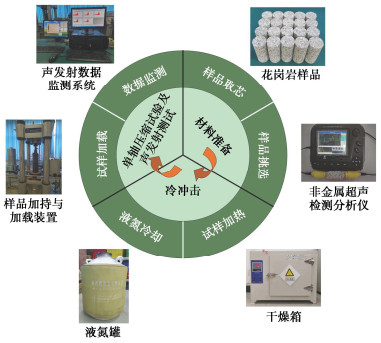
 下载:
下载:




